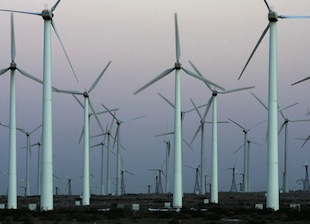
Conway Irwin
December 7, 2013
GreenTechMedia
Morgan Stanley is seeing “vicious competition” between coal plants and wind farms in resource-rich regions.
More efficient technologies, combined with low costs and strong wind resources, are making wind cost-competitive with some of the cheapest forms of fossil energy in the Midwest.
“In the Midwest, we’re now seeing power agreements being signed with wind farms at as low as $25 per megawatt-hour,” said Stephen Byrd, Morgan Stanley’s Head of North American Equity Research for Power & Utilities and Clean Energy, at the Columbia Energy Symposium in late November. “Compare that to the variable cost of a gas plant at $30 per megawatt-hour. The all-in cost to justify the construction of a new gas plant would be above $60 per megawatt-hour.”
Byrd acknowledged that wind does receive a subsidy in the form of a production tax credit for ten years at $22 per megawatt-hour after tax. “But even without that subsidy, some of these wind projects have a lower all-in cost than gas,” Byrd said.
“The trick with both wind and solar is…the very high fixed costs to build these technologies. The ongoing variable cost is close to nil. So you’ve got to cover your capital costs over as many units of power production as you can. Which is why, in the Midwest, a wind farm can produce power at a capacity factor of 50-plus percent, that’s a lot of units of power to spread your capital costs over, and that’s why the cost of these agreements can be in the $25 range.”
Wind is even going head-to-head with Powder River Basin coal. “In the Midwest, those wind plants are, many times of the day, competing against efficient nuclear plants and efficient PRB coal plants,” Byrd said. “PRB coal plants have a variable cost of between $20 and $25 per megawatt-hour, so in the Midwest, it’s fairly vicious competition between very efficient wind farms — which are always called on first because they have no variable cost — and coal and nuclear.”
Byrd stressed that the conditions that make wind so competitive in the Midwest — strong wind resources and low costs, both for labor and construction — are not present in other regions. But where wind works, it can make good economic sense. U.S. wind capacity last year grew to 60 gigawatts, in the context of total U.S. capacity of all energy types totaling 1,100 gigawatts.
“I’m not suggesting that nationwide, wind is at or below the economics of a gas plant, but we are seeing in the best locations that wind is becoming good business — big business,” said Byrd.
And he expects technology to continue to improve, which could further enhance wind’s competitiveness. “We know the technology is getting better; none of us can exactly forecast how much better.”

